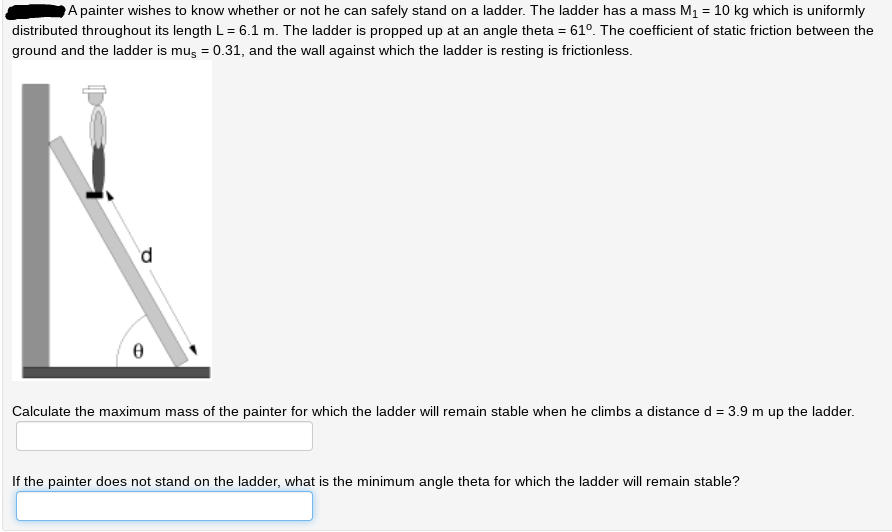A painter wishes to know whether or not he can safely stand on a ladder. The ladder has a mass M₁ = 10 kg which is uniformly distributed throughout its length L = 6.1 m. The ladder is propped up at an angle theta = 61º. The coefficient of static friction between the ground and the ladder is mus = 0.31, and the wall against which the ladder is resting is frictionless. Ꮎ Calculate the maximum mass of the painter for which the ladder will remain stable when he climbs a distance d = 3.9 m up the ladder. f the painter does not stand on the ladder, what is the minimum angle theta for which the ladder will remain stable?
A painter wishes to know whether or not he can safely stand on a ladder. The ladder has a mass M₁ = 10 kg which is uniformly distributed throughout its length L = 6.1 m. The ladder is propped up at an angle theta = 61º. The coefficient of static friction between the ground and the ladder is mus = 0.31, and the wall against which the ladder is resting is frictionless. Ꮎ Calculate the maximum mass of the painter for which the ladder will remain stable when he climbs a distance d = 3.9 m up the ladder. f the painter does not stand on the ladder, what is the minimum angle theta for which the ladder will remain stable?
Physics for Scientists and Engineers: Foundations and Connections
1st Edition
ISBN:9781133939146
Author:Katz, Debora M.
Publisher:Katz, Debora M.
Chapter14: Static Equilibrium, Elasticity, And Fracture
Section: Chapter Questions
Problem 64PQ: A One end of a metal rod of weight Fg and length L presses against a corner between a wall and the...
Related questions
Concept explainers
Rotational Equilibrium And Rotational Dynamics
In physics, the state of balance between the forces and the dynamics of motion is called the equilibrium state. The balance between various forces acting on a system in a rotational motion is called rotational equilibrium or rotational dynamics.
Equilibrium of Forces
The tension created on one body during push or pull is known as force.
Question

Transcribed Image Text:A painter wishes to know whether or not he can safely stand on a ladder. The ladder has a mass M₁ = 10 kg which is uniformly
distributed throughout its length L = 6.1 m. The ladder is propped up at an angle theta = 61º. The coefficient of static friction between the
ground and the ladder is mus = 0.31, and the wall against which the ladder is resting is frictionless.
0
Calculate the maximum mass of the painter for which the ladder will remain stable when he climbs a distance d = 3.9 m up the ladder.
If the painter does not stand on the ladder, what is the minimum angle theta for which the ladder will remain stable?
Expert Solution
This question has been solved!
Explore an expertly crafted, step-by-step solution for a thorough understanding of key concepts.
Step by step
Solved in 3 steps with 2 images

Knowledge Booster
Learn more about
Need a deep-dive on the concept behind this application? Look no further. Learn more about this topic, physics and related others by exploring similar questions and additional content below.Recommended textbooks for you

Physics for Scientists and Engineers: Foundations…
Physics
ISBN:
9781133939146
Author:
Katz, Debora M.
Publisher:
Cengage Learning

Physics for Scientists and Engineers, Technology …
Physics
ISBN:
9781305116399
Author:
Raymond A. Serway, John W. Jewett
Publisher:
Cengage Learning

Physics for Scientists and Engineers: Foundations…
Physics
ISBN:
9781133939146
Author:
Katz, Debora M.
Publisher:
Cengage Learning

Physics for Scientists and Engineers, Technology …
Physics
ISBN:
9781305116399
Author:
Raymond A. Serway, John W. Jewett
Publisher:
Cengage Learning